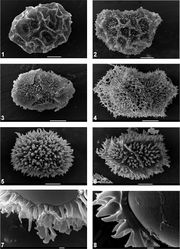Oleandra sibbaldii
| Notice: | This page is derived from the original publication listed below, whose author(s) should always be credited. Further contributors may edit and improve the content of this page and, consequently, need to be credited as well (see page history). Any assessment of factual correctness requires a careful review of the original article as well as of subsequent contributions.
If you are uncertain whether your planned contribution is correct or not, we suggest that you use the associated discussion page instead of editing the page directly. This page should be cited as follows (rationale):
Citation formats to copy and paste
BibTeX: @article{Hovenkamp2012PhytoKeys11, RIS/ Endnote: TY - JOUR Wikipedia/ Citizendium: <ref name="Hovenkamp2012PhytoKeys11">{{Citation See also the citation download page at the journal. |
Ordo: Polypodiales
Familia: Oleandraceae
Genus: Oleandra
Name
Oleandra sibbaldii Hovenkamp & Ho, 2012 – Wikispecies link – Pensoft Profile
- Oleandra sibbaldii Grev., Ann.and Mag.Nat.Hist.Ser.2 1: 327. 1848. Copel., Bull. Bernice P. Bishop Mus. 93: 61. 1932. Philipp. J. Sci. 73: 346. 1940. C.Chr., Bull. Bernice P. Bishop Mus. 177 47. 1943. Copel., Fern Flora of the Philippines: 183. 1958. Brownlie, The Pteridophyte Flora of Fiji: 157. 1977. M.Kato, J. Fac. Sci. Univ. Tokyo, Sect. 3, Bot. 14: 239. 1989. R.M.Tryon, Rhodora 102: 436, fig. 7. 2001. Oleandra cumingii var. sibbaldii Baker, Syn. Fil. (Hooker & Baker): 303. 1868. Type: FRENCH POLYNESIA. Tahiti: Sibbald s.n. (holotype: E, barcode E00417634, not seen).
- Oleandra tricholepis Kunze, Kunze, Bot. Zeitung (Berlin) 9: 349. 1851. Type. INDONESIA. Bornea: Hupe s.n. (holotype: LZ, probably destroyed).
- Oleandra whitmeei Baker, J. Bot. 5: 11. 1876. (“whitmei”). Oleandra whitmeei Copel., Polypod. Phil. Isl.: 49. 1905. Copel., Bull. Bernice P. Bishop Mus. 59 87. 1929. Type. SAMOA. Savai’i : Whitmee & Powell s.n. (holotype: K).
- Oleandra gracilis Copel., Univ. Calif. Publ. Bot. 12: 397, pl. 52b. 1931. Copel.Philipp. J. Sci. 73: 347. 1940. Type: PAPUA NEW GUINEA. New Guinea: Keysser 74 (holotype: UC).
- Oleandra crassipes Copel., Philipp. J. Sci. 73: 347, Pl. 2. 1940. Type: INDONESIA. New Guinea: Bernhard camp, Brass 12109 (holotype: UC; isotypes: BO, L).
Description
Rhizome long-creeping or pendulous, sparsely branching, 1.5–4.5 mm thick, very strongly white waxy, in cross-section without or with few scattered sclerified strands, phyllopodia scattered, (0.3–)0.8–4.0(–5.7) cm long, roots with distinct unbranched parts. Scales deciduous, exposing the rhizome in older parts, peltate, (3–)5–15(–18) × (0.3–)0.4–0.9(–1.2) mm, usually widest above the attachment, squarrose, reddish brown, margin entire or more or less densely set with sessile glands, acumen attenuated, long filiform apex. Fronds monomorphic; stipe (0.3–)0.5–3.5(–4.5) cm long, often with dark coloration on abaxial side; lamina to (4.5–)15–40(–58) × 1–4(–6) cm, widest in middle part, base attenuate to cuneate, sometimes rounded, rarely truncate, sometimes asymmetric, apex acuminate or up to 3 cm caudate, texture membranous to coriaceous, both sides sparsely to densely set with catenate hairs to c. 0.5 mm long; costa on lower surface often with dark-coloration, on both surfaces with scales, scales on lower surface often abundant, to 6(–11) × 1(–1.2) mm, pale to dark brown, on upper surface scarce, inconspicuous. Sori inframedial, leaving a distinct 1–4 mm wide sterile zone between costa and soral zone, sometimes as much as 12 mm from costa, indusium firm, to 1 mm wide, hairy. Sporangial stalk with glands below the sporangium. Spores with an irregular mesh-like network of up to 10 µm high folds, finely papillose with spinules up to ca. 4 × 1 μm, perispore baculate, outer layer much perforated.
Distribution
Eastern Malesia to Pacific Islands. Malaysia: Sabah, Sarawak, Philippines: Mindanao; Indonesia: Sulawesi; Moluccas, Papua; Papua New Guinea; Solomon islands; Vanuatu; Tahiti and Marquesas: Hiva Oa, Nuku Hiva, Tahuata, Ua Huka and Ua Pou; Western Samoa: Savaii; Fiji.
Ecology
Epiphytic, epilithic, or less commonly terrestrial (most often at elevations over 1500m), commonly collected from mossy forests, climbing or sprawling among bryophytes and other epiphytes, or pendulous from mossy tree branches, to 600 m (Marquesas and Tahiti); or from 1000 to 3000 m (elsewhere).
Discussion
Oleandra sibbaldii is common on New Guinea, but appears to be much sparser towards the periphery of the distribution area.
The dark colour on the abaxial surface of the costa is often very conspicuous, extending on the stipe, thus rendering the stipe conspicuously bicolorous.
Taxon Treatment
- Hovenkamp, P; Ho, B; 2012: A revision of the fern genus Oleandra (Oleandraceae) in Asia PhytoKeys, 11: 1-37. doi
Images
|

